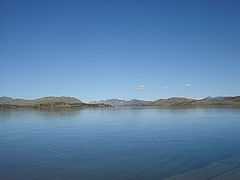Lake Laberge
| Lake Laberge | |
|---|---|
 Lake Laberge in August 2010; picture taken from campground | |
| Location | Yukon |
| Coordinates | 61°10′N 135°10′W / 61.167°N 135.167°WCoordinates: 61°10′N 135°10′W / 61.167°N 135.167°W |
| Primary inflows | Yukon River |
| Primary outflows | Yukon River |
| Catchment area | 68,744,433 m2 (739,958,920 sq ft) |
| Basin countries | Canada |
| Max. width | 5 km (3.1 mi) |
| Water volume | 444 km3 (107 cu mi) |
Lake Laberge is a widening of the Yukon River north of Whitehorse, Yukon in Canada. It is fifty kilometres long and ranges from two to five kilometres wide. Its water is always very cold, and its weather often harsh and suddenly variable.
The Tagish knew it as Kluk-tas-si, and the Tlingit as Tahini-wud.[1] Its English name comes from 1870 commemorating Robert de La Berge (1638–1712), one of the original colonists of New France (1658). It was well-known to prospectors during the Klondike Gold Rush of the 1890s, as they would pass Lake Laberge on their way down the Yukon River to Dawson City. Jack London's Grit of Women (1900) and The Call of the Wild (1903), and Robert W. Service's poem "The Cremation of Sam McGee" (1907) mention the lake.
During the late 19th and early 20th centuries, after-winter steamers carrying goods on Lake Laberge early on in the shipping season regarded the lake as trouble, since it was one of the last such passages to thaw its ice. At least two methods were employed to break the ice up:
- Method 1. Allow a surging gout of water to be released from the control dam below Marsh Lake, thereby expanding the lake waters suddenly below the surface of the ice, forcing cracks for the water to burble up through, or
- Method 2. Smear an abundant quantity of expended crankcase oil along the lake's icy length, causing it to melt by increasing the sun's warming effect.[1]
A sign posted in 1999 at Lake Laberge's camping area issued strong cautions against eating the livers of burbot, and counseled against the consumption of lake trout more than twice a month per individual. Both warnings are owed to toxaphene contamination, resulting from global pesticide use and overfishing in Lake Laberge which resulted in changes to its typical food chain.[1]
In Spring 2009, researchers found the A. J. Goddard, a Gold Rush sternwheeler that sunk in 1901, killing three of its crew. Underwater archaeologists are examining the ship. National Geographic has named it the top archeological find of 2009. The Yukon government has designated the shipwreck a historic site. A phonograph with three records was discovered, giving insight into songs being listened to during the Gold Rush.[2]
References and notes
External links
| Wikimedia Commons has media related to Lake Laberge. |